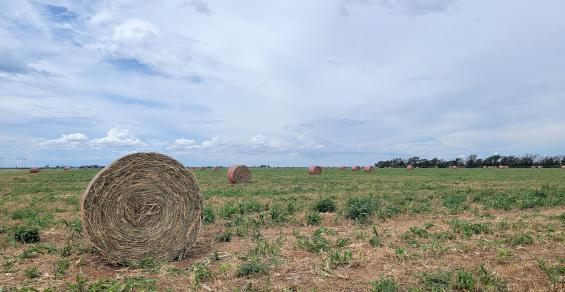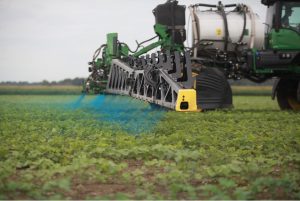Forage producers are dealing with the ripple effects of dry conditions, sporadic cold temperatures and below-average cool-season production as hay supplies tighten for cattle operations, according to Texas A&M AgriLife Extension Service reports.
Hay producers are also facing production decisions due to high fertilizer costs that could contribute to even tighter supplies going into next fall.
The U.S. Drought Monitor reported that moisture levels continue to decline in most of the state. Less than 4% of the state reported no drought conditions, while more than 70% of the state was experiencing severe to exceptional drought. Wildfires, fueled by dry, windy conditions, have covered more than 46,000 acres throughout Eastland County.
AgriLife Extension reports from multiple regions shared concerns among cattle producers regarding dwindling hay supplies as they provide larger rations of hay and feed to maintain body conditions amid poor cool-season grazing.
Vanessa Corriher-Olson, AgriLife Extension forage specialist in the Department of Soil and Crop Sciences, Overton, said weather has reduced production of cool-season forages like ryegrass, wheat and oats for baling and/or grazing. Conditions have been dry, but cold fronts and freezing weather have also contributed to poor forage production.
“It has been such a mild winter with sporadic cold weather, and it feels like we have received rains here and there, but nothing very significant,” she said. “We are dry, and our winter forages need moisture, so producers, at least in East Texas, are not having the success they’ve seen in the past.”
Forage producers see increased demand for bales
Reagan Noland, AgriLife Extension agronomist, San Angelo, said western parts of the state are also dealing with poor forage production conditions. Last hay season was better than average due to above-average rainfall, but the supply depleted quickly as drought set in.
Forage Specialist Vanessa Corriher-Olson anticipates higher demand for hay going forward if producers statewide are hesitant to fertilize. (Photos by Shelley E. Huguley)
New growth for winter grazing has been non-existent due to a lack of measurable rainfall since early September, he said. Livestock producers have relied on stockpiled forage including standing dormant forages leftover from the growing season, baled hay and feed.
“A lot of local hay is being donated to livestock producers affected by the wildfires in Central Texas,” he said. “But I believe supplies are dwindling quickly.”
Corriher-Olson said hay quality and quantity in East Texas were below average due to excess rains throughout the hay season last year.
Bermuda grass was slow to emerge due to cooler, overcast conditions, which delayed the first cutting, she said. Subsequent rains denied access to fields for fertilization, weed and insect pest control, and timely harvests, which compounded quality and cutting issues. High humidity and tight windows to cure cut hay also led to diminished quality.
“The value was lowered because hay was cut and then rained on or the cutting was delayed past peak nutritional value,” she said. “Armyworms were another issue challenging forage producers’ ability to access pastures. There were a lot of factors that influenced cuttings, and ultimately the quantity and quality of hay last year.”
Fertilizer alternatives, maximizing input investments
Corriher-Olson said the chief concern now among cattle and forage producers is high fertilizer prices. The economics of paying premium prices for nitrogen, phosphorous and potassium may cause some producers to reduce applications or forgo fertilizing hay fields at all, which would have a major impact on quality and yields.
Many forage producers are already seeking alternative fertilizers like poultry litter as a way to put nutrients in the soil, she said.
Corriher-Olson said producers need to test their soils to determine exactly how much nitrogen, phosphorous and potassium summer forages need to grow if rain arrives and persist if it remains dry.
“Most producers think about the nitrogen, and yes, it is important for production, but potassium provides persistence, especially through drought,” she said. “I worry they will cut back on potassium, which could lead to thinning or poor stands the following season.”
Forage producers also need to focus on timing applications to maximize efficiency, she said. Splitting nitrogen applications can decrease leaching and volatility. She also suggested producers wait until nighttime temperatures are in the 60s consistently to be sure Bermuda grasses are out of dormancy and growing.
“Some producers get antsy, but paying attention to temperature and timing is critical, otherwise you’re just fertilizing weeds,” she said.
Forage producers should plan ahead
Weed control should be another top priority for hay producers to minimize competition for forages, Corriher-Olson said. But for producers with fenced meadows and water sources, this year might be a good time to graze more and concentrate inputs on the cleanest, best hay production acres. Cattle will recycle nutrients while grazing, and producers can maximize quality and yields where they cut and bale.
Corriher-Olson anticipates higher demand for hay going forward if producers statewide are hesitant to fertilize.
“Ranchers have to consider their need and invest accordingly because prices per bale are likely to go up as hay producers recoup their input costs,” she said. “It is best to weigh options and plan now rather than face even more difficult decisions later.”
AgriLife Extension district reporters compiled the following summaries:
The 12 Texas A&M AgriLife Extension Districts
CENTRAL
Dry conditions continued to dominate. Soil moisture levels were very short in a majority of counties. Strong winds brought concerns about fire conditions. Limited rain last week slowed planting down for a day, but future rain forecasts looked promising. Corn planting was just about finished with very few acres remaining. Sorghum planting was nearly complete. Wheat was in good condition but could use some precipitation. A very minor amount of cereal leaf beetle damage was seen in wheat. Producers were seeing lady beetle adults, indicating that aphid numbers may be increasing. Pasture conditions improved slightly with some cool season grasses starting to show up. Cattle remained in good condition with producers still feeding hay. Stock tanks were getting lower and lower with the limited rainfall and low runoff totals. Rangeland and pasture conditions were generally poor in a majority of counties.
ROLLING PLAINS
Conditions were dry and windy. Pastures and winter wheat fields looked bad. Producers were not top-dressing with fertilizer due to the cost and bad crop conditions. Hay supplies and fire danger were major concerns. Most wheat fields were in poor conditions, but some were able to be grazed, and deer were still a problem for the few that were producing. Wind erosion was becoming a problem.
COASTAL BEND
Most areas had not received measurable rain in 45 days, but northern parts of the reporting area received a small amount of rain this past week. Crop planting was still in high gear despite dry conditions. Some cotton was being planted, but most growers were waiting for soil temperatures to improve. Rice planting was underway. Corn and sorghum were also being planted with some fields already emerged, but they needed moisture. Cool temperatures continued to delay green-up of warm-season pastures. Livestock pasture forages were getting short, and hay and protein feeding continued. Cattle remained in good condition with sale prices at very high levels.
EAST
The district received rainfall, but most counties still needed much more. Harrison County, however, reported almost 4 inches with more in the forecast. Pasture and rangeland conditions were very poor to poor. Subsoil and topsoil conditions were short to adequate. Grass growth was slow, and producers continued to provide supplemental feed to cattle. Some producers were culling beef cattle herds. Livestock were in fair to good condition. Fertilizer prices remained high, forcing producers to seek alternatives such as poultry litter.
SOUTH PLAINS
Dry conditions continued across the district. All agriculture needed moisture. Producers were busy preparing fields for spring planting. Farmers were also weighing their crop options according to the current drought and high input costs. Farmers were watering wheat and triticale. Dryland wheat needed relief from dry, windy conditions to be salvageable. Cattle were on supplemental feed due to lack of cool-season forages, and native grasses were still dormant.
PANHANDLE
Soil moisture conditions were very short to short. Crop, rangeland and pasture conditions were very poor to poor. Dry conditions worsened. Producers were finishing up limited fieldwork in the dry conditions. Irrigation was needed for tillage, and wheat was being irrigated.
NORTH
Soil moisture ranged from short to adequate, and the weather was generally good for planting. Temperatures were warming up, and some rainfall was received. There was concern about long-term drought, and producers were trying to locate hay supplies and secure contracts early. Wheat needed rain but improved significantly across the county since the latest rain events and warmer days. Oats were starting to grow well. Most counties reported fair to good wheat and oat conditions. Most corn and sorghum fields were planted. Pasture and rangeland were in very poor to fair condition. Cattle were in good condition and in the middle of spring calving season. Spring calves were looking good.
FAR WEST
Temperatures reached the mid-80s with lows in the low-20s. There were no reports of precipitation, and winds 30-45 mph caused blowing sand and limited visibility to less than an eighth of a mile in many situations. Conditions made it hard for ranchers to work cattle. There were reports of high winds damaging crops and water systems plus evaporating much of the soil moisture from pre-irrigated fields. Very little fieldwork was being done as producers tried to limit input costs. A regional cotton gin finally finished ginning a record harvest. Area cow/calf producers were working calves and selling more livestock, especially cattle, due to cost-prohibitive supplemental feeding. Sheep and goat producers were finishing up lambing and kidding and will begin marketing soon. Fire red flag warnings were issued for most of the district, and many fires had broken out, including one that burned around 4,000 acres. Rangeland conditions were poor. Pre-irrigation for row crop fields continued, including some irrigation for pecan orchards and remaining alfalfa. Irrigation in portions of the Lower Valley was effluent/treated sewage from the City of El Paso, El Paso County Water Improvement District No. 1 wells and some private wells. Water was scheduled to be released from Elephant Butte Reservoir in late May, which would deliver water to El Paso County in early June.
WEST CENTRAL
Very dry conditions caused extreme fire danger across the region, worsened by extreme winds. Wildfires broke out around the area and burned an estimated 8,000 acres in Coleman County. Several head of livestock were lost to the fire. Rangelands and pastures were in poor to fair condition. The winter wheat crop was in mostly poor to fair condition. Spring growth was slow due to dry conditions. Some fieldwork was done in preparation for spring plantings.
SOUTHEAST
Rice farmers were planting and trying to beat the possible large amounts of rain in the forecast. Rains slowed down fieldwork in a few counties. Livestock were in good condition. Winter forages were in good condition with the recent precipitation and favorable weather. Pastures and hay fields were slowly showing warm-season perennial grass growth. Rangeland and pasture conditions were very poor to fair. Cool-season forages were struggling to reach normal production levels. Vegetable plantings were in various stages from preparations to planted depending on operators. Several days of windy conditions dried previously worked soil quickly.
SOUTHWEST
Very dry conditions were persistent with no rainfall reported. Dry conditions increased the likelihood of wildfire. Pasture and rangeland conditions were steadily decreasing without precipitation. Winter wheat looked good under irrigation. Corn and sorghum planting continued. Spring lambing and kidding continued. Cattle, sheep and goat markets were consistent. Livestock were in fair condition and supplemental feeding continued for both livestock and wildlife. Wildlife looked thin.
SOUTH
Northern, eastern and western parts of the district reported very short to short moisture levels while southern areas reported adequate moisture. Conditions were windy and cloudy with cool mornings and warm afternoons. Fieldwork and spring planting continued, and crop fields were being irrigated. Most corn and grain sorghum were planted, and cotton planting was well underway. A few sesame and soybean acres were planted. Citrus, sugarcane and vegetables were being harvested. Rangeland and pasture conditions continued to decline, and producers continued to provide hay and feed. Stock tanks were low, and some producers were hauling water. Beef cattle markets saw high volumes as producers continued to cull herds. Cull cow and bull prices were high. Body condition scores continued to decline. Several fires were reported.
Texas Crop and Weather Report – March 22, 2022





